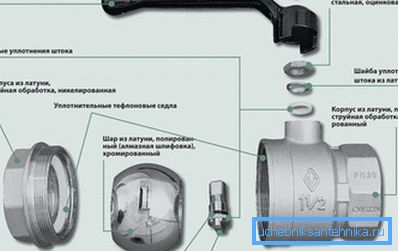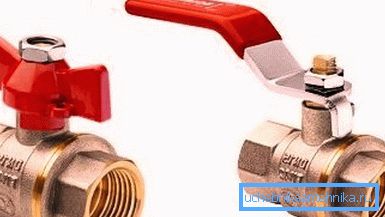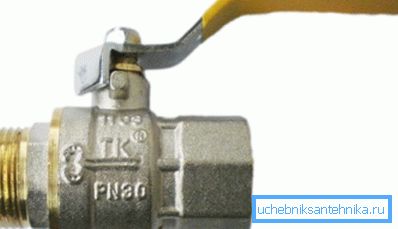Crane 11b27p1: device, characteristics, versions,
How does the 11b27p1 brass ball valve work? What media, temperatures, and pressures is it designed for? What designs of this product can be found on sale? Finally, how does the manufacturer recommend installing and using this product? Let's figure it out.

Description
Device
The 11b27p ball valve is arranged quite traditionally for this type of valves:
- The function of the gate is performed by a ball with a through channel in it.
- Rotation is transmitted from the handle to the ball through the stem passing through the collapsible body.
- Sealing the ball and stem is made of polymeric sealing rings.
Specify: polymer stem sealer is not the only solution for ball valves. Along with it, rubber rings are often used - alas, far less wear-resistant.
What materials is the product made of? Depending on the manufacturer, small variations of alloy grades are possible here. Therefore, the technical characteristics of the 11b27p crane given by us will be the most common, but not the only option.
| Construction element | Material |
| Housing | Brass LS59-1 (GOST 15527-2004) |
| Ball valve | Brass LS59-1 with H9X coating (alloy of nickel and chrome) |
| Lever | Aluminum AK-7 coated with epoxy polyester paint |
| Compactor | Fluoroplastic F4 |

Curiously: the color of the handle indicates the area of application of the product. Red indicates valves for hot and cold water. The gas valve 11b27p is marked in yellow.
Specifications
The main technical characteristics of the ball valve 11b27p1 quite ordinary:
- Working pressure is 16 atmospheres. Actually, it is indicated in the product labeling: an inscription of the type DU25 RU16 indicates that we have a valve with a nominal diameter of 25 mm and with a working pressure of 16 kgf / cm2.
- Operating temperature range - from -30 (for gas transportation) to +150 С.
The price of the valve DN15 RU16 is 96 rubles; with an increase in nominal size, it is understandably increasing. Growing and weight indicators:
| Nominal size | Assembly length, mm | Weight, kg |
| DN15 | 50 | 0.158 |
| DN20 | 57 | 0,290 |
| DU25 | 72 | 0.540 |
| DU32 | 90 | 1,300 |
| DU40 | 110 | 2,000 |
| DN50 | 115 | 2,600 |
The full list of working media with which the valve can work is not given by manufacturers. They are limited to all liquid and gaseous substances that are non-aggressive to the product materials.
Execution options
The list of variations also does not strike length.
Numerous dealers can offer a picky buyer:
- Two versions of the handle - lever and butterfly. The first is convenient because it requires less effort to reposition the shutter; the second is in demand where compactness is needed.

- Several ways of joining - external thread, internal thread, American, and their various combinations.
Recommendations for installation and maintenance
- Before installing the valve, examine it for cracks, deformations and test its performance by turning the handle. It should turn smoothly, without sticking and with moderate effort.
- The crane is mounted in the fully open position. The instruction is designed to prevent debris from entering between the hull and seats.
- It is recommended to use FUM tape or sanitary flax as a reel.

Photographer's comment: FUM tape gives a leak with a minimum reverse thread course, so it is better to replace it with a polymer thread. It is desirable to impregnate flax with paint, varnish or silicone sealant for pipes: then it will not rot when in contact with water.
- The valve with internal thread is screwed onto the connecting pipe 3-4 turns up to the comfortable position of the handle. Turning with great effort is unacceptable: it is better to dismantle the valve, re-thread the thread and re-screw the housing onto the nozzle.
- As a tool for mounting the valve with their own hands, manufacturers strongly recommend the use of an open-end wrench. Attempting to tighten it with a gas wrench is a sure way to crack the hull: sponges squeeze relatively thin brass with a dangerous force.
- Maintenance comes down to tightening the gland nut as the seal progresses. As a rule, the need for this occurs after 1000 or more cycles; full product life is estimated at 4 - 10 thousand cycles. In the domestic context, this meaning can be considered synonymous with the word eternity.

Evaluation
The characteristics given by dealers and manufacturers are faceless and do not give an answer to the main question: is it worth buying this product?
Yes. Definitely.
Before us is an exceptionally good representative of modern valves.
- All 11b27p - full bore. The hole in the gate corresponds to the diameter of the pipe to be connected, which means minimal hydraulic resistance. In fact, the valve does not cause a greater pressure drop than a section of a polymer pipe of the same length.
- Valves are mounted with any direction of flow medium. In this way, they compare favorably with any screw valve, which, with a countercurrent, is constantly threatened by a valve break.
- About the eternal nightmare of plumbing - the need for periodic revision and maintenance of valves - you can finally completely forget. No, revision is still desirable; but now it comes down to a periodic (once every 1-2 years) turn of the valve handle.
- Finally, the production according to domestic standards and specifications means that the buyer will not run into another miracle with the silumin case crumbling at the first contact with the key. Actually, the yellow color of brass without chrome plating leaves no room for doubt.

Conclusion
We hope that our recommendations will help the reader in choosing materials for their own projects. Additional thematic information, as usual, will offer a video in this article. Successes!